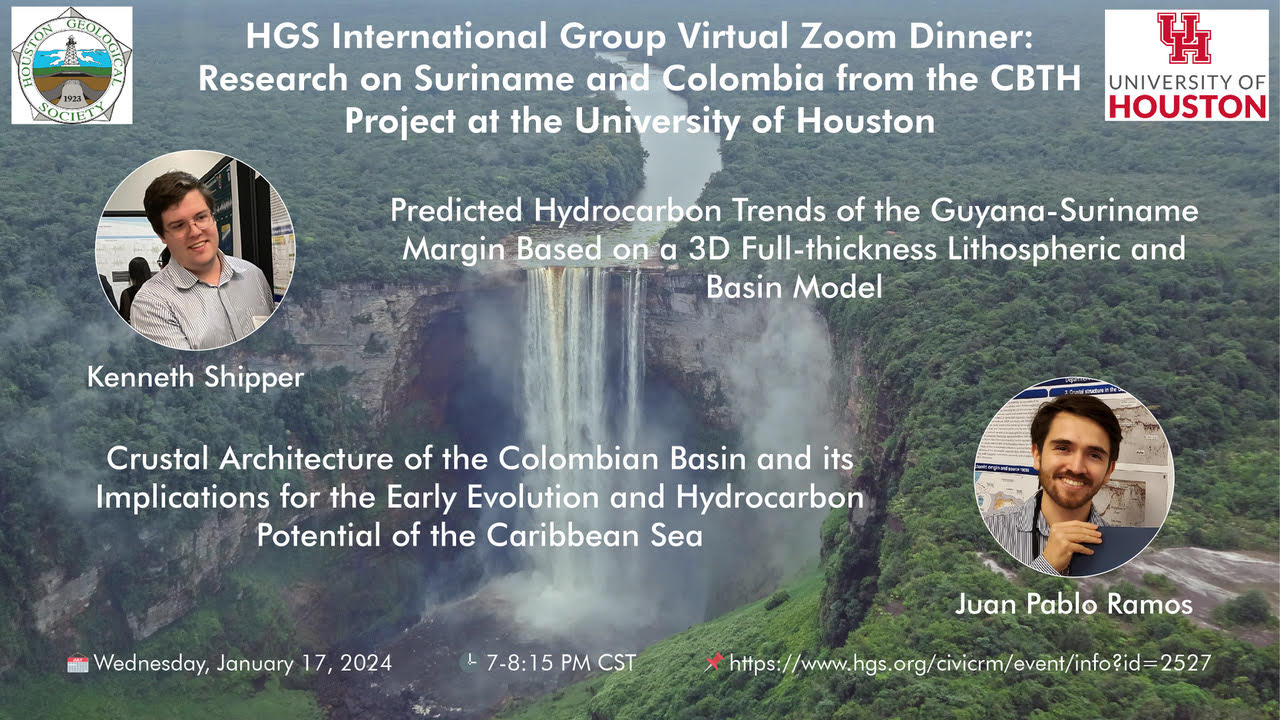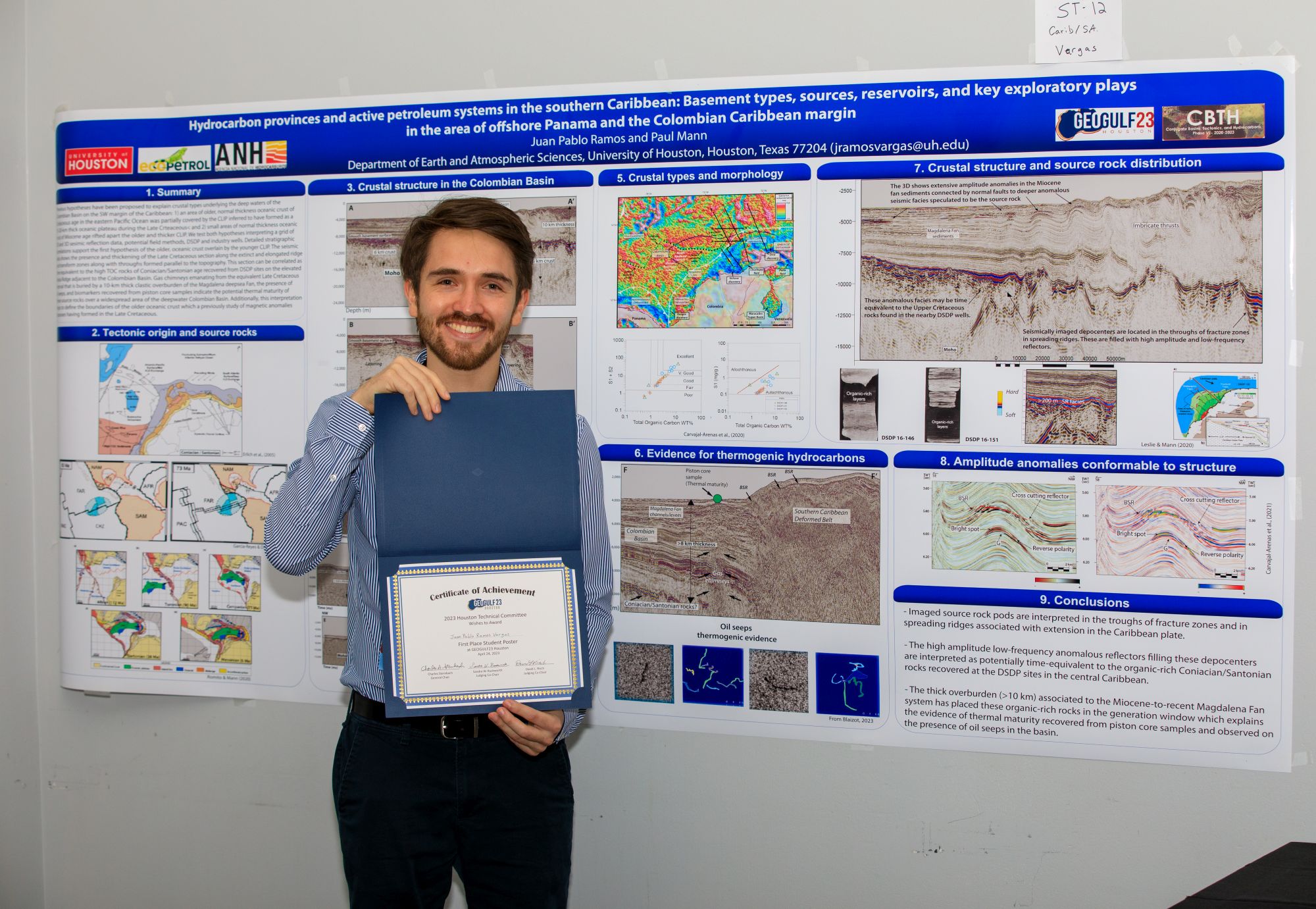ZOOM: Research on Suriname and Colombia from U of H
In order to register, please click login to either sign in to an existing account or create a user profile. Go to the HGS home page and login with your user name and password and then return to this page in order to register as a member or guest of a member. For help registering contact the HGS office or email webmaster@hgs.org. Thank you!
HGS International Group Virtual Zoom Dinner
Wednesday, January 17, 7:00PM to 8:15PM
(the meeting had been changed to be a dinner zoom, not a luncheon zoom)
Two back-to-back presentations
Talk 1
Predicted Hydrocarbon Trends of the Guyana-Suriname Margin Based on a 3D Full-thickness Lithospheric and Basin Model
Speaker: Kenneth Shipper, Ph.D. student in Geophysics,
University of Houston Department of Earth and Atmospheric Sciences
Talk 2
Crustal Architecture of the Colombian Basin and its Implications for the Early Evolution and Hydrocarbon Potential of the Caribbean Sea
speaker: Juan Pablo Ramos Vargas
Ph.D student in Geology at the University of Houston
Zoom Meeting will be hosted by Steve Getz. Register here and a zoom link will be sent a day before the January 17 meeting.
__________________________________________
Abstract from Ken Shipper
The 8-km-thick, rifted-passive margin of northeastern South America in Guyana and northwestern Suriname thins from 40-50 km thick crust of the Guiana shield to 6-8 km Jurassic oceanic crust over a 167-74 km tapered necked zone. As hydrocarbon exploration continues offshore from the highly productive “Miracle Mile” along the slope of Guyana and northwestern Suriname, prediction of future trends for productive offshore drilling will depend on quantifying lateral variations in thermal stress related to crustal thickness and type, source rock thickness and type, and overburden thickness. My study has completed a 3D basin model based on a new 3D gravity inversion constrained from previous refraction surveys and my interpretations of a 2D KPSTM seismic grid. Three crustal domains were identified based on basalt flow extent previously indicated by seaward dipping reflectors (SDRs) related to the Demerara volcanic margin in southeastern Suriname. The crustal structure of the margin was constrained using seismic, and radiogenic heat production (RHP) from thermal modeling. s adjacent to the continent-ocean boundary. The resulting 3D thermal stress model shows increasing maturity is validated by the successful oil and gas fields and predicts how the productive areas will extend onto the elevated area of the Demerara volcanic margin.

Kenneth Shipper is a second-year Ph.D student at the University of Houston Earth and Atmospheric Sciences Department. working with Dr. Paul Mann. and CBTH Consortium. Ken earned a BS in Geophysics and Seismology at the University of Houston in 2021. He supported the UH GeoSociety student group as President in 2020. Ken presented posters on his research at the GeoGulf23 Conference in April and at the HGS Sheriff Lecture in November 2023.
______________________________________________
Crustal Architecture of the Colombian Basin and its Implications for the Early Evolution and Hydrocarbon Potential of the Caribbean Sea
by Juan Pablo Ramos y Vargas
This talk aims to present new insights into the geology, tectonostratigraphic evolution, and potential petroleum systems in the deep and ultra-deep waters of the Colombian Caribbean margin. I summarize the exploration potential of the 235,000 km 2 Magdalena Fan System, one of the last large unexplored, deep sea fan systems in the world. I also provide a detailed analysis of 1) the basement fabric and crustal structure of the Colombian and Venezuelan basins; 2) the stratigraphy and sedimentary sequences that infilled areas above these differing basement types; and 3) how the basement morphology and overlying basins have led to potential petroleum systems known from direct hydrocarbon indicators.
This paper is based on the interpretation of 8,210 km of 2D seismic data, 13,000 km 2 of 3D seismic data, the compilation, and integration of published information from scientific (DSDP/ODP) and hydrocarbon exploratory wells, sea-floor samples, oil seeps, geochemical evaluations, potential field methods, and seismic refraction data (Figure 1). The seismic data used for this project was provided by the oil and gas industry and includes recently acquired and processed seismic reflection data in the Colombian Basin and the Northern Panama Deformed Belt (NPDB).
Interpretations from potential gravimetric and magnetometry methods reveal the basement architecture and the location of the main depocenters in the area. Our results show that the basement in the ultra-deep waters of the Colombian Basin consists of parallel basement ridges bounded on both sides by troughs with more than 20 km extension that formed as Cretaceous spreading ridges in the central Caribbean. These now-extinct spreading centers were also interpreted based on the satellite gravity and magnetic maps. This Cretaceous basement fabric had a direct impact on the sedimentary fill evidenced by the presence of high amplitude reflectors filling the troughs as potential source rock pods, which could be timeequivalent to the Upper Cretaceous rocks drilled by DSDP/ODP wells 153, 151, and 146 where organic-rich intervals in the Coniacian interval are well documented.
The upper part of this pelagic sedimentary sequence contrasts with turbidites, and deep-water deposits associated with the development of the Miocene and younger Magdalena Fan, as well as a marked interpreted MTCs of possible Pleistocene age, observed over a large extension of the basin. This thick accumulation of Miocene to recent clastic rocks reaches values greater than 10 km and provides
high-quality reservoirs, seals, and overburden for underlying source rocks of Turonian-Santonian age.
This turbidite Miocene-to-recent sedimentary sequence shows in the 2D lines and the 3D survey numerous amplitude anomalies that are consistent with 4-way structures with more than 8 km of length located mainly at the toe of the slope. The relationship between the location of these structures with recent piston core results, and the presence of oil seeps, allows us to conclude the potential presence
of a deep and ultra-deepwater petroleum system with potential thermogenic origin.
In addition, the geology interpreted in the Northern Panama Deformed Belt shows the marked presence of Bottom Simulating Reflectors (BSRs), as well as gas chimneys that support the deeper water extensions,5 TCF, recent gas discoveries along the Colombian Caribbean margin that include Gorgon, Orca, Kronos and Uchuva.
The results derived from this work bring new insights into the geological understanding of the little-explored Colombian Basin and the Northern Panama Deformed Belt. Interpretation of seismic data acquired by the oil industry during the last 10 years allows for more detailed analysis of their tectonostratigraphic evolution, as well as guiding future exploration activities in the region. In addition,
the integration of our seismic interpretation with recent evidence from seafloor samples and oil seeps in the region supports a deepwater thermogenic system that has not been drilled by exploratory wells to date.
Juan Pablo received his BS degree in geology from the National University of Colombia and is currently a Ph.D. candidate in geology at the University of Houston. As a researcher with the Conjugate Basins Tectonics and Hydrocarbons (CBTH) Consortium he has published research on the tectonostratigraphic evolution of frontier deepwater sedimentary basins of the Caribbean and its implications for hydrocarbon exploratory potential.
 Juan Pablo Ramos Vagas at GeoGulf 23
Juan Pablo Ramos Vagas at GeoGulf 23
United States
| Fees | |
| HGS Member | $ 25.00 |
| HGS Non-Member | $ 40.00 |
| Student | $ 15.00 |
| Emeritus | $ 15.00 |
|
Speaker Info
|
|
Event Attachments
|
|
Event Contact
|
|
Committee
|
|
Event Filter Informations
|


